height SUZUKI GRAND VITARA 2001 2.G Owners Manual
[x] Cancel search | Manufacturer: SUZUKI, Model Year: 2001, Model line: GRAND VITARA, Model: SUZUKI GRAND VITARA 2001 2.GPages: 656, PDF Size: 14.31 MB
Page 10 of 656
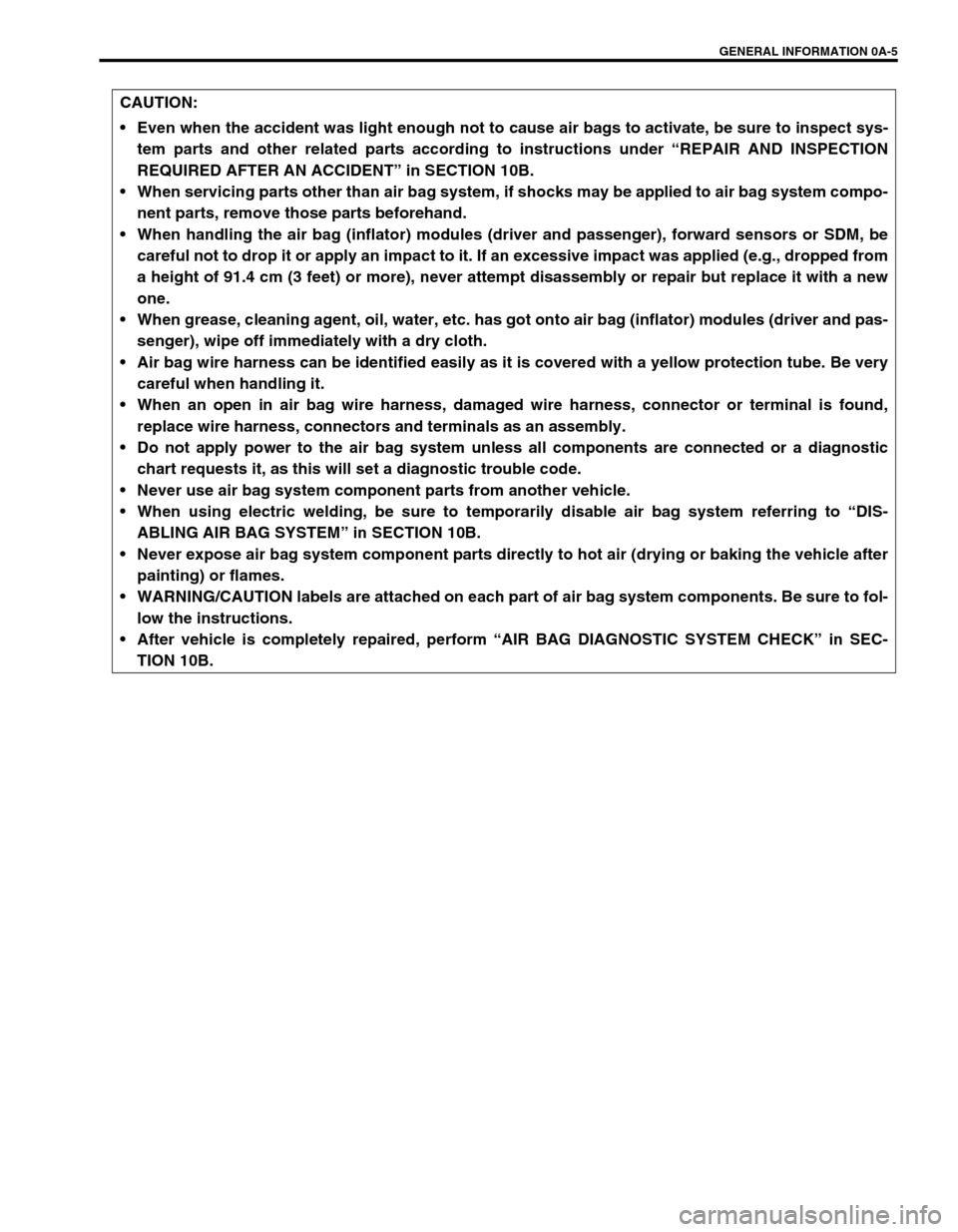
GENERAL INFORMATION 0A-5
CAUTION:
Even when the accident was light enough not to cause air bags to activate, be sure to inspect sys-
tem parts and other related parts according to instructions under “REPAIR AND INSPECTION
REQUIRED AFTER AN ACCIDENT” in SECTION 10B.
When servicing parts other than air bag system, if shocks may be applied to air bag system compo-
nent parts, remove those parts beforehand.
When handling the air bag (inflator) modules (driver and passenger), forward sensors or SDM, be
careful not to drop it or apply an impact to it. If an excessive impact was applied (e.g., dropped from
a height of 91.4 cm (3 feet) or more), never attempt disassembly or repair but replace it with a new
one.
When grease, cleaning agent, oil, water, etc. has got onto air bag (inflator) modules (driver and pas-
senger), wipe off immediately with a dry cloth.
Air bag wire harness can be identified easily as it is covered with a yellow protection tube. Be very
careful when handling it.
When an open in air bag wire harness, damaged wire harness, connector or terminal is found,
replace wire harness, connectors and terminals as an assembly.
Do not apply power to the air bag system unless all components are connected or a diagnostic
chart requests it, as this will set a diagnostic trouble code.
Never use air bag system component parts from another vehicle.
When using electric welding, be sure to temporarily disable air bag system referring to “DIS-
ABLING AIR BAG SYSTEM” in SECTION 10B.
Never expose air bag system component parts directly to hot air (drying or baking the vehicle after
painting) or flames.
WARNING/CAUTION labels are attached on each part of air bag system components. Be sure to fol-
low the instructions.
After vehicle is completely repaired, perform “AIR BAG DIAGNOSTIC SYSTEM CHECK” in SEC-
TION 10B.
Page 302 of 656
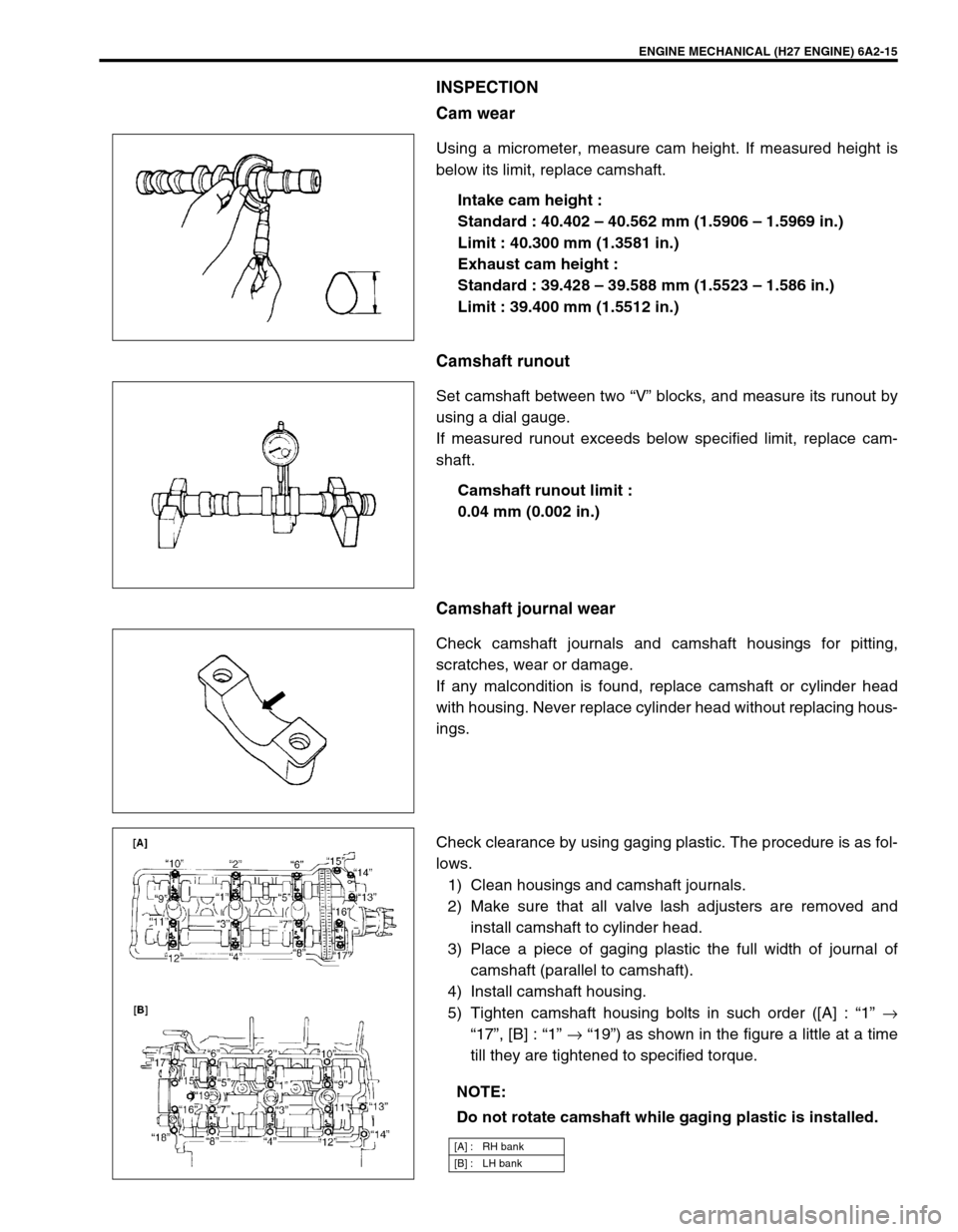
ENGINE MECHANICAL (H27 ENGINE) 6A2-15
INSPECTION
Cam wear
Using a micrometer, measure cam height. If measured height is
below its limit, replace camshaft.
Intake cam height :
Standard : 40.402 – 40.562 mm (1.5906 – 1.5969 in.)
Limit : 40.300 mm (1.3581 in.)
Exhaust cam height :
Standard : 39.428 – 39.588 mm (1.5523 – 1.586 in.)
Limit : 39.400 mm (1.5512 in.)
Camshaft runout
Set camshaft between two “V” blocks, and measure its runout by
using a dial gauge.
If measured runout exceeds below specified limit, replace cam-
shaft.
Camshaft runout limit :
0.04 mm (0.002 in.)
Camshaft journal wear
Check camshaft journals and camshaft housings for pitting,
scratches, wear or damage.
If any malcondition is found, replace camshaft or cylinder head
with housing. Never replace cylinder head without replacing hous-
ings.
Check clearance by using gaging plastic. The procedure is as fol-
lows.
1) Clean housings and camshaft journals.
2) Make sure that all valve lash adjusters are removed and
install camshaft to cylinder head.
3) Place a piece of gaging plastic the full width of journal of
camshaft (parallel to camshaft).
4) Install camshaft housing.
5) Tighten camshaft housing bolts in such order ([A] : “1” →
“17”, [B] : “1” → “19”) as shown in the figure a little at a time
till they are tightened to specified torque.
NOTE:
Do not rotate camshaft while gaging plastic is installed.
[A] : RH bank
[B] : LH bank
Page 317 of 656
![SUZUKI GRAND VITARA 2001 2.G Owners Manual 6A2-30 ENGINE MECHANICAL (H27 ENGINE)
Main Bearings, Crankshaft and Cylinder Block
1. Cylinder block 6. Rear oil seal 11. O-ring [A]: Sealant application amount
2. Lower crankcase :
Apply sealant 9900 SUZUKI GRAND VITARA 2001 2.G Owners Manual 6A2-30 ENGINE MECHANICAL (H27 ENGINE)
Main Bearings, Crankshaft and Cylinder Block
1. Cylinder block 6. Rear oil seal 11. O-ring [A]: Sealant application amount
2. Lower crankcase :
Apply sealant 9900](/img/20/7584/w960_7584-316.png)
6A2-30 ENGINE MECHANICAL (H27 ENGINE)
Main Bearings, Crankshaft and Cylinder Block
1. Cylinder block 6. Rear oil seal 11. O-ring [A]: Sealant application amount
2. Lower crankcase :
Apply sealant 99000-31150 to lower
crankcase mating surface.7. Flywheel (M/T) Drive plate
(A/T)12. Clutch housing plate Tightening Torque
3. Crankshaft 8. Water pump 13. Cap bolt Do not reuse
4. Main bearing 9. O-ring 14. Lower crankcase bolt Apply engine oil to sliding
surface of each parts.
5. Thrust bearing :
Set bearing facing grooved side to
crank weds.10. Timing chain oil jet 15. Knock sensor“a”: Width 3 mm (0.12 in.)
“b”: Height 2 mm (0.08 in.)
Page 347 of 656

6E2-14 ENGINE AND EMISSION CONTROL SYSTEM (SEQUENTIAL MULTIPORT FUEL INJECTION FOR H27 ENGINE)
Accelerator Cable Adjustment
1) With throttle valve closed, check accelerator pedal play
which should be within following specification.
If measured value is out of specification, adjust accelerator
cable (1) to specification with cable adjusting nut (2).
Accelerator pedal play “a”:
2 – 5 mm (0.08 – 0.20 in.)
2) With accelerator pedal depressed fully, check clearance
between throttle lever (2) and lever stopper (1) (throttle body)
which should be within following specification.
If measured value is out of specification, adjust it to specifi-
cation by changing height of pedal stopper bolt (3).
Clearance “b” between throttle lever and lever stopper
(throttle body) (with accelerator pedal depressed fully):
0.5 – 2.0 mm (0.02 – 0.07 in.)
A/T Throttle Cable Adjustment (A/T Vehicle)
1) Make sure that accelerator cable is adjusted as specified.
2) With throttle valve closed, check clearance “c” which should
be within the following specification.
If it is out of specification, adjust A/T throttle cable (1) by
turning cable adjusting nut (2).
A/T throttle cable installing position specification clear-
ance “c”:
0.8 – 1.5 mm (0.03 – 0.06 in.)
Page 498 of 656
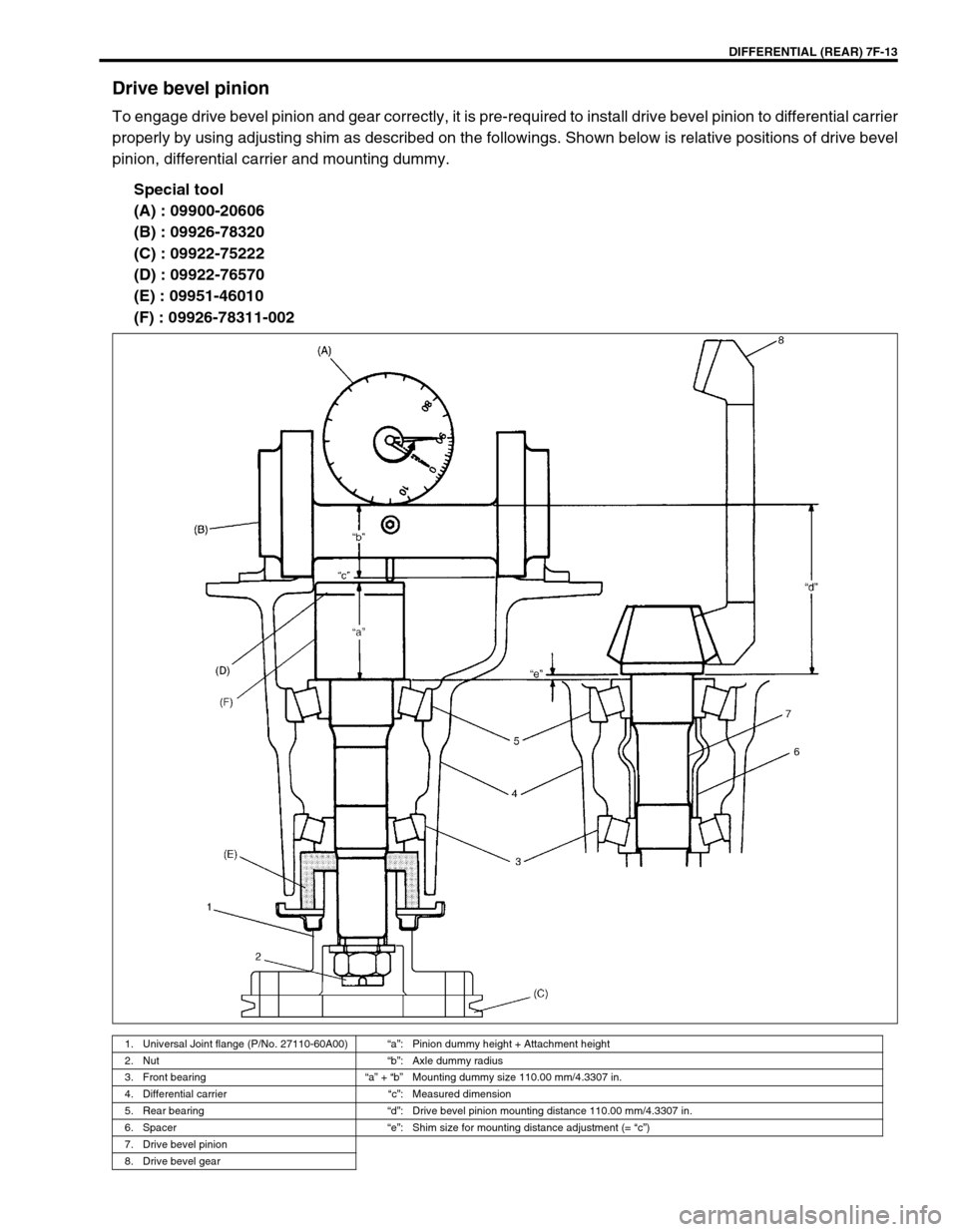
DIFFERENTIAL (REAR) 7F-13
Drive bevel pinion
To engage drive bevel pinion and gear correctly, it is pre-required to install drive bevel pinion to differential carrier
properly by using adjusting shim as described on the followings. Shown below is relative positions of drive bevel
pinion, differential carrier and mounting dummy.
Special tool
(A) : 09900-20606
(B) : 09926-78320
(C) : 09922-75222
(D) : 09922-76570
(E) : 09951-46010
(F) : 09926-78311-002
1. Universal Joint flange (P/No. 27110-60A00)“a”: Pinion dummy height + Attachment height
2. Nut“b”: Axle dummy radius
3. Front bearing“a” + “b”Mounting dummy size 110.00 mm/4.3307 in.
4. Differential carrier“c”: Measured dimension
5. Rear bearing“d”: Drive bevel pinion mounting distance 110.00 mm/4.3307 in.
6. Spacer“e”: Shim size for mounting distance adjustment (= “c”)
7. Drive bevel pinion
8. Drive bevel gear
Page 505 of 656
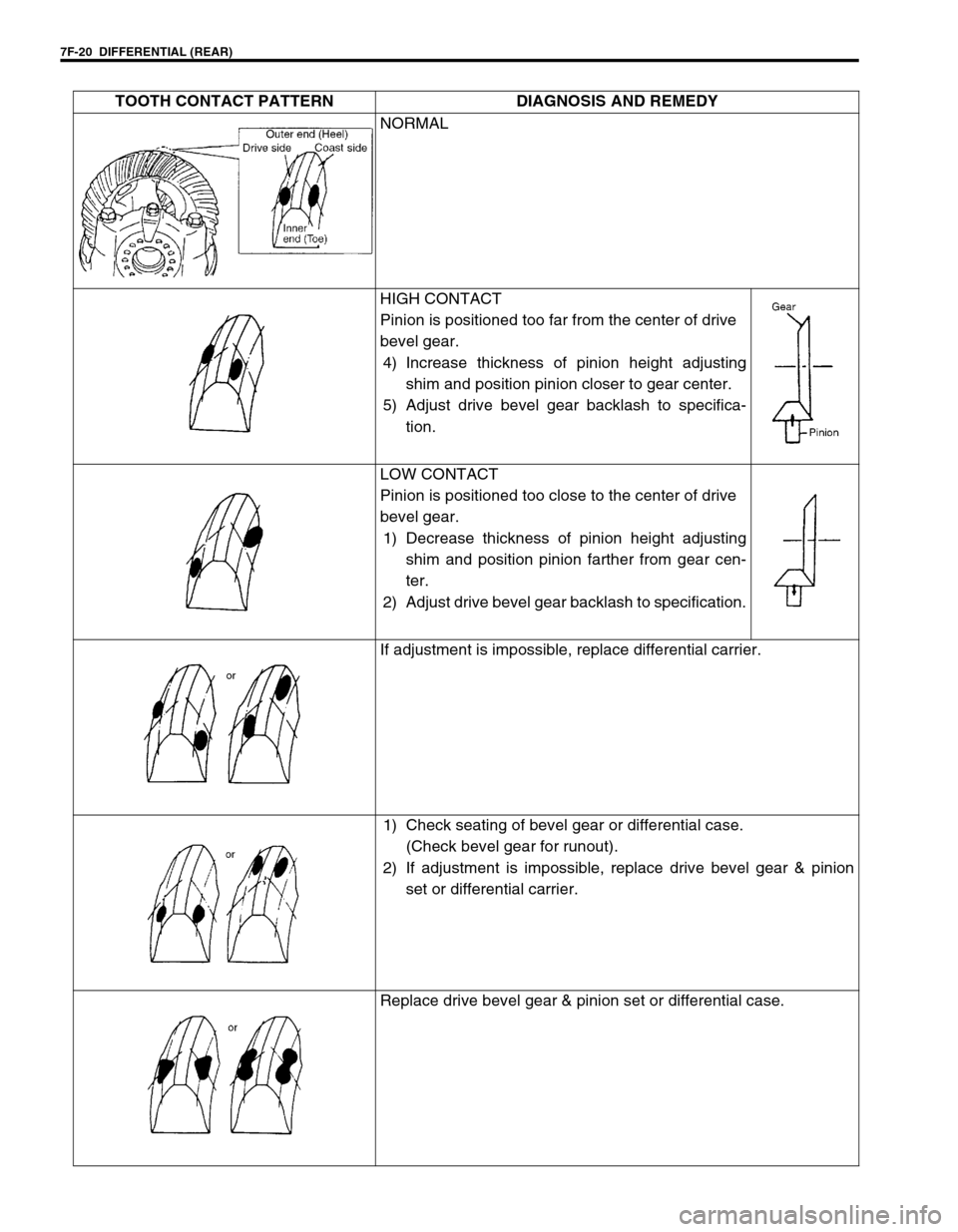
7F-20 DIFFERENTIAL (REAR)
TOOTH CONTACT PATTERN DIAGNOSIS AND REMEDY
NORMAL
HIGH CONTACT
Pinion is positioned too far from the center of drive
bevel gear.
4) Increase thickness of pinion height adjusting
shim and position pinion closer to gear center.
5) Adjust drive bevel gear backlash to specifica-
tion.
LOW CONTACT
Pinion is positioned too close to the center of drive
bevel gear.
1) Decrease thickness of pinion height adjusting
shim and position pinion farther from gear cen-
ter.
2) Adjust drive bevel gear backlash to specification.
If adjustment is impossible, replace differential carrier.
1) Check seating of bevel gear or differential case.
(Check bevel gear for runout).
2) If adjustment is impossible, replace drive bevel gear & pinion
set or differential carrier.
Replace drive bevel gear & pinion set or differential case.
Page 547 of 656
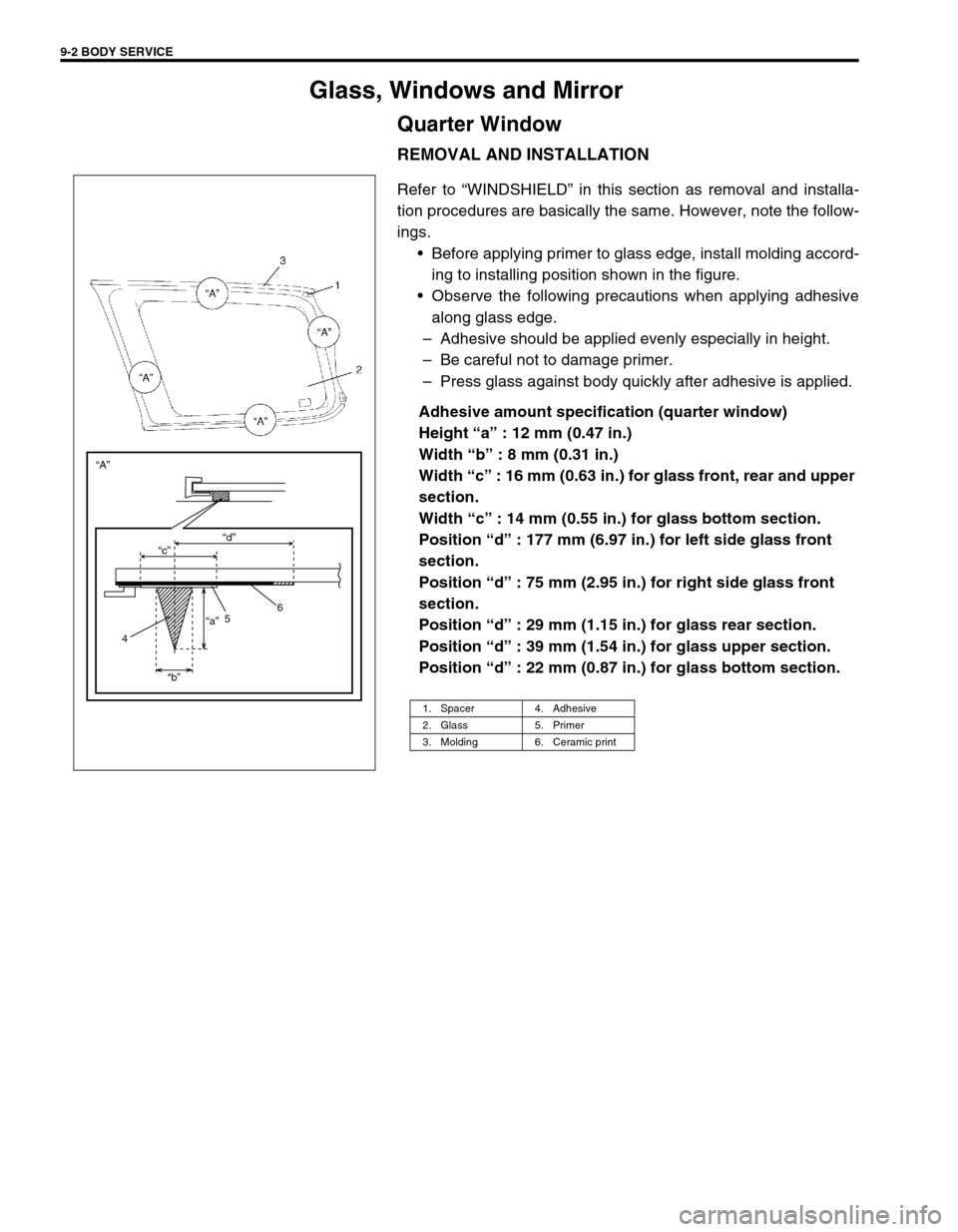
9-2 BODY SERVICE
Glass, Windows and Mirror
Quarter Window
REMOVAL AND INSTALLATION
Refer to “WINDSHIELD” in this section as removal and installa-
tion procedures are basically the same. However, note the follow-
ings.
•Before applying primer to glass edge, install molding accord-
ing to installing position shown in the figure.
•Observe the following precautions when applying adhesive
along glass edge.
–Adhesive should be applied evenly especially in height.
–Be careful not to damage primer.
–Press glass against body quickly after adhesive is applied.
Adhesive amount specification (quarter window)
Height “a” : 12 mm (0.47 in.)
Width “b” : 8 mm (0.31 in.)
Width “c” : 16 mm (0.63 in.) for glass front, rear and upper
section.
Width “c” : 14 mm (0.55 in.) for glass bottom section.
Position “d” : 177 mm (6.97 in.) for left side glass front
section.
Position “d” : 75 mm (2.95 in.) for right side glass front
section.
Position “d” : 29 mm (1.15 in.) for glass rear section.
Position “d” : 39 mm (1.54 in.) for glass upper section.
Position “d” : 22 mm (0.87 in.) for glass bottom section.
1. Spacer 4. Adhesive
2. Glass 5. Primer
3. Molding 6. Ceramic print
“c” “A”
“a”
“b”“d”
6
5
4
Page 573 of 656
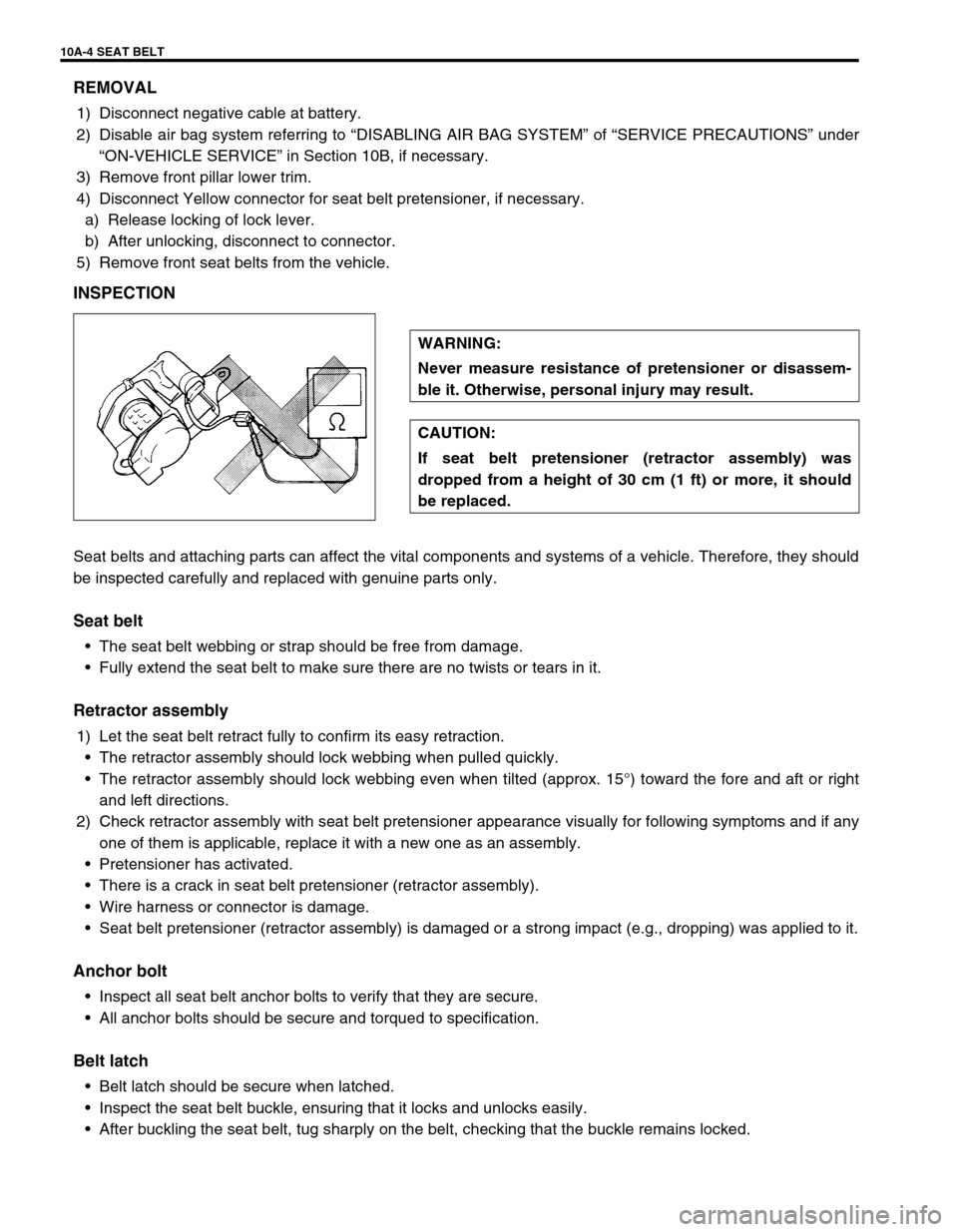
10A-4 SEAT BELT
REMOVAL
1) Disconnect negative cable at battery.
2) Disable air bag system referring to “DISABLING AIR BAG SYSTEM” of “SERVICE PRECAUTIONS” under
“ON-VEHICLE SERVICE” in Section 10B, if necessary.
3) Remove front pillar lower trim.
4) Disconnect Yellow connector for seat belt pretensioner, if necessary.
a) Release locking of lock lever.
b) After unlocking, disconnect to connector.
5) Remove front seat belts from the vehicle.
INSPECTION
Seat belts and attaching parts can affect the vital components and systems of a vehicle. Therefore, they should
be inspected carefully and replaced with genuine parts only.
Seat belt
•The seat belt webbing or strap should be free from damage.
•Fully extend the seat belt to make sure there are no twists or tears in it.
Retractor assembly
1) Let the seat belt retract fully to confirm its easy retraction.
•The retractor assembly should lock webbing when pulled quickly.
•The retractor assembly should lock webbing even when tilted (approx. 15°) toward the fore and aft or right
and left directions.
2) Check retractor assembly with seat belt pretensioner appearance visually for following symptoms and if any
one of them is applicable, replace it with a new one as an assembly.
•Pretensioner has activated.
•There is a crack in seat belt pretensioner (retractor assembly).
•Wire harness or connector is damage.
•Seat belt pretensioner (retractor assembly) is damaged or a strong impact (e.g., dropping) was applied to it.
Anchor bolt
•Inspect all seat belt anchor bolts to verify that they are secure.
•All anchor bolts should be secure and torqued to specification.
Belt latch
•Belt latch should be secure when latched.
•Inspect the seat belt buckle, ensuring that it locks and unlocks easily.
•After buckling the seat belt, tug sharply on the belt, checking that the buckle remains locked.WARNING:
Never measure resistance of pretensioner or disassem-
ble it. Otherwise, personal injury may result.
CAUTION:
If seat belt pretensioner (retractor assembly) was
dropped from a height of 30 cm (1 ft) or more, it should
be replaced.
Page 626 of 656
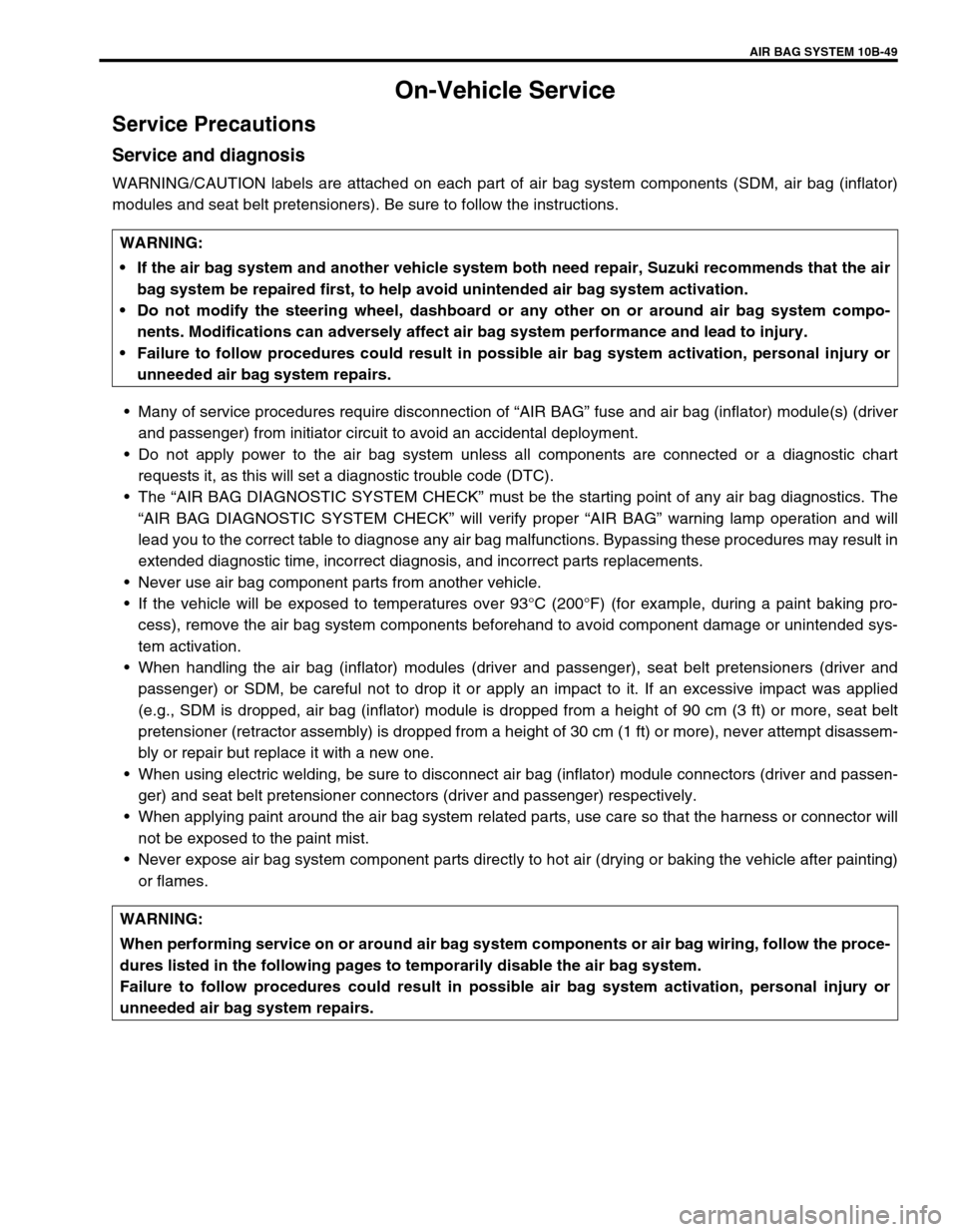
AIR BAG SYSTEM 10B-49
On-Vehicle Service
Service Precautions
Service and diagnosis
WARNING/CAUTION labels are attached on each part of air bag system components (SDM, air bag (inflator)
modules and seat belt pretensioners). Be sure to follow the instructions.
•Many of service procedures require disconnection of “AIR BAG” fuse and air bag (inflator) module(s) (driver
and passenger) from initiator circuit to avoid an accidental deployment.
•Do not apply power to the air bag system unless all components are connected or a diagnostic chart
requests it, as this will set a diagnostic trouble code (DTC).
•The “AIR BAG DIAGNOSTIC SYSTEM CHECK” must be the starting point of any air bag diagnostics. The
“AIR BAG DIAGNOSTIC SYSTEM CHECK” will verify proper “AIR BAG” warning lamp operation and will
lead you to the correct table to diagnose any air bag malfunctions. Bypassing these procedures may result in
extended diagnostic time, incorrect diagnosis, and incorrect parts replacements.
•Never use air bag component parts from another vehicle.
•If the vehicle will be exposed to temperatures over 93°C (200°F) (for example, during a paint baking pro-
cess), remove the air bag system components beforehand to avoid component damage or unintended sys-
tem activation.
•When handling the air bag (inflator) modules (driver and passenger), seat belt pretensioners (driver and
passenger) or SDM, be careful not to drop it or apply an impact to it. If an excessive impact was applied
(e.g., SDM is dropped, air bag (inflator) module is dropped from a height of 90 cm (3 ft) or more, seat belt
pretensioner (retractor assembly) is dropped from a height of 30 cm (1 ft) or more), never attempt disassem-
bly or repair but replace it with a new one.
•When using electric welding, be sure to disconnect air bag (inflator) module connectors (driver and passen-
ger) and seat belt pretensioner connectors (driver and passenger) respectively.
•When applying paint around the air bag system related parts, use care so that the harness or connector will
not be exposed to the paint mist.
•Never expose air bag system component parts directly to hot air (drying or baking the vehicle after painting)
or flames. WARNING:
If the air bag system and another vehicle system both need repair, Suzuki recommends that the air
bag system be repaired first, to help avoid unintended air bag system activation.
Do not modify the steering wheel, dashboard or any other on or around air bag system compo-
nents. Modifications can adversely affect air bag system performance and lead to injury.
Failure to follow procedures could result in possible air bag system activation, personal injury or
unneeded air bag system repairs.
WARNING:
When performing service on or around air bag system components or air bag wiring, follow the proce-
dures listed in the following pages to temporarily disable the air bag system.
Failure to follow procedures could result in possible air bag system activation, personal injury or
unneeded air bag system repairs.
Page 629 of 656
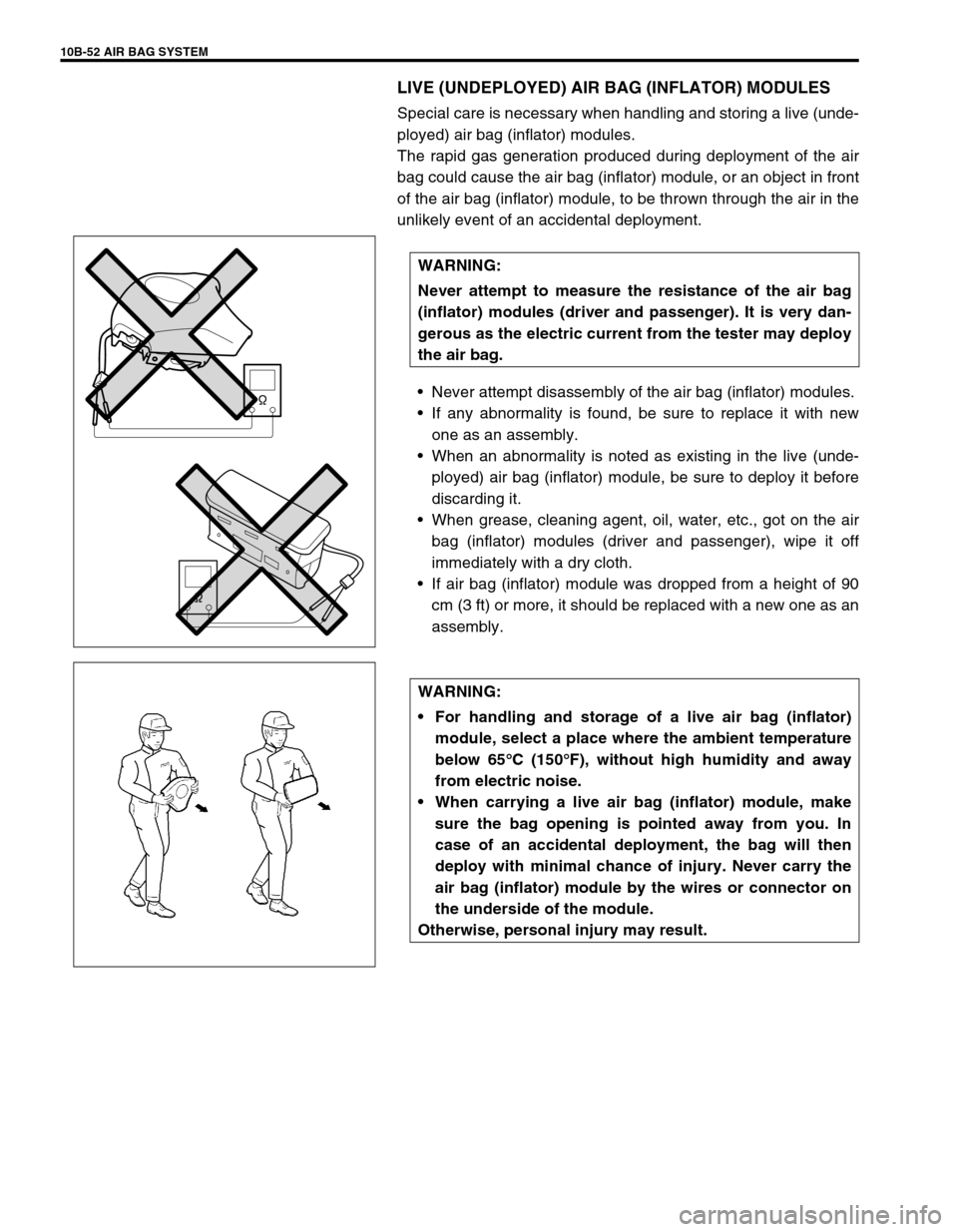
10B-52 AIR BAG SYSTEM
LIVE (UNDEPLOYED) AIR BAG (INFLATOR) MODULES
Special care is necessary when handling and storing a live (unde-
ployed) air bag (inflator) modules.
The rapid gas generation produced during deployment of the air
bag could cause the air bag (inflator) module, or an object in front
of the air bag (inflator) module, to be thrown through the air in the
unlikely event of an accidental deployment.
•Never attempt disassembly of the air bag (inflator) modules.
•If any abnormality is found, be sure to replace it with new
one as an assembly.
•When an abnormality is noted as existing in the live (unde-
ployed) air bag (inflator) module, be sure to deploy it before
discarding it.
•When grease, cleaning agent, oil, water, etc., got on the air
bag (inflator) modules (driver and passenger), wipe it off
immediately with a dry cloth.
•If air bag (inflator) module was dropped from a height of 90
cm (3 ft) or more, it should be replaced with a new one as an
assembly. WARNING:
Never attempt to measure the resistance of the air bag
(inflator) modules (driver and passenger). It is very dan-
gerous as the electric current from the tester may deploy
the air bag.
WARNING:
For handling and storage of a live air bag (inflator)
module, select a place where the ambient temperature
below 65°
°° °C (150°
°° °F), without high humidity and away
from electric noise.
When carrying a live air bag (inflator) module, make
sure the bag opening is pointed away from you. In
case of an accidental deployment, the bag will then
deploy with minimal chance of injury. Never carry the
air bag (inflator) module by the wires or connector on
the underside of the module.
Otherwise, personal injury may result.